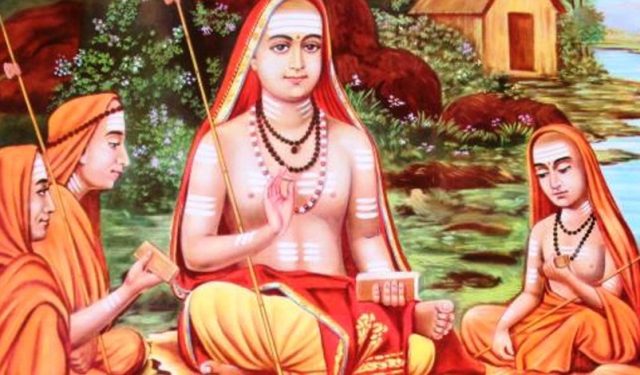
Adi Shankaracharya was not merely one person—in his persona, we find an expression of Bharat
The significance of Shankaracharya (eighth-ninth century CE) in Indian history and spirituality can hardly be overstated. Living in the ninth century, what Shankaracharya brought about was truly monumental.
One way of thinking about his great endeavours is to map the spots where he founded the seats of learning which are occupied, to this day, by great individuals in Shankaracharya’s own lineage. There is some dispute, occasionally, about which of these great seats are the most authentic, but Jyotirmath in the Himalayas, Govardhanmath in Puri (Odisha), Sharadamath in Dwarka (Gujarat), Shringerimath (Karnataka) and the Kamakoti Math in Kanchi (Tamil Nadu), are significant.
Regardless of which of the last two we consider to be the chief southern seat (both of them have been occupied by individuals of staggering spiritual stature, worthy of being in the lineage of the great teacher), it is clear that the vision Shankaracharya had for Bharat is particularly significant to us in two ways- this entire region, marked by these seats in which he installed a direct disciple each, constituted for him a single whole; and the essence of this whole was its spirituality. In line with this, he is also credited with organising the renunciates of the region into the dashanami order, which continues to this day.
The intellectual achievement of Shankaracharya is truly staggering. He composed a lucid commentary on the Brahma-sutras, or the Vedanta-sutras, in which he articulated the identity of the atman with brahman, and referred extensively to the Upanishads as he did so. In addition, he composed commentaries on the Upanishads and the Bhagavadgītā. At the same time, he is also credited with the composition of the Saundaryalahari, the Srividya text par excellence, which reveals the greatest mysteries of the cosmos to the initiated, and reads as beautiful prayer to the uninitiated.
The intellectual achievement of Shankaracharya is truly staggering. He composed a lucid commentary on the Brahma-sutras, or the Vedanta-sutras, in which he articulated the identity of the atman with brahman, and referred extensively to the Upanishads as he did so
Just as significant, however, is the persistence of Shankaracharya in the everyday lives of people. Large portions of the hymns recited everyday by numerous people in India (and the diaspora) are believed to have been composed by Shankaracharya. It reflects the way Shankaracharya has been understood by people, and also how Bharat understands, instinctively, her own spirituality.
The simplicity with which the Atma-Shataka (the sextet on the atman) denies all identification with parts of the body, religious observance, even punya and paap, and declares Shivo’ham—I am Shiva—and the ease with which people continue to sing it, tells us something deeply significant about the spiritual attitudes and understanding in the country. It is not that each person who sings it is in that state of consciousness, or rather, has removed all her misidentifications; it means more that each of them knows this to be the Truth, which is to be unveiled for herself. At the same time, many of these hymns are deeply devotional, reminding us that the Indian way is not unitary, but rather knows all these to be approached to the same reality.
By Shaan Kashyap
Courtesy: Orginser














